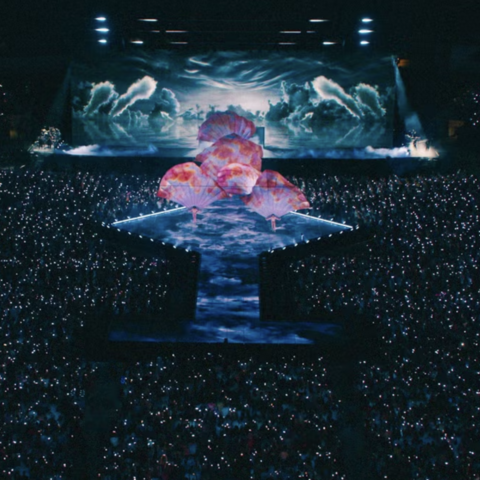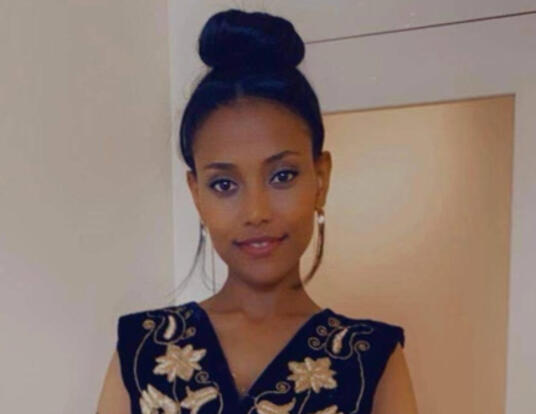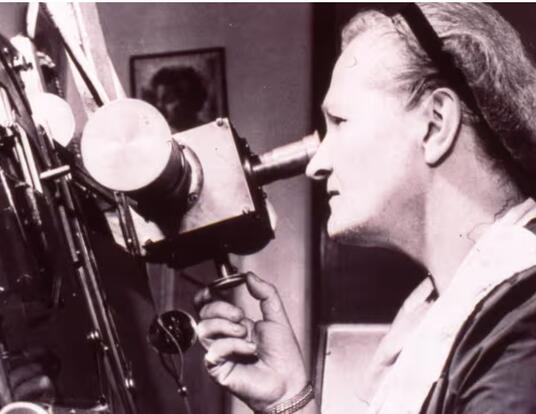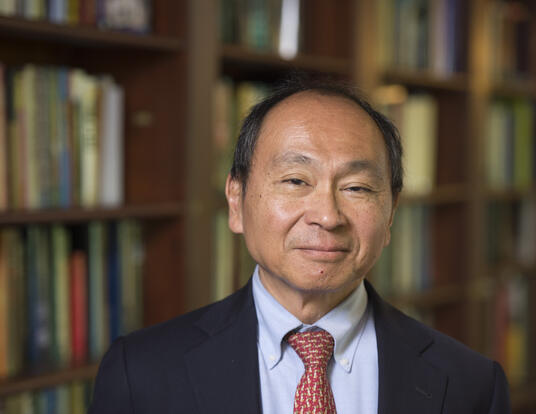(Sesqui)centennial Medalists
Harvard Griffin GSAS closes out its anniversary celebration by honoring alums who epitomize the School’s inquiry, innovation, and impact
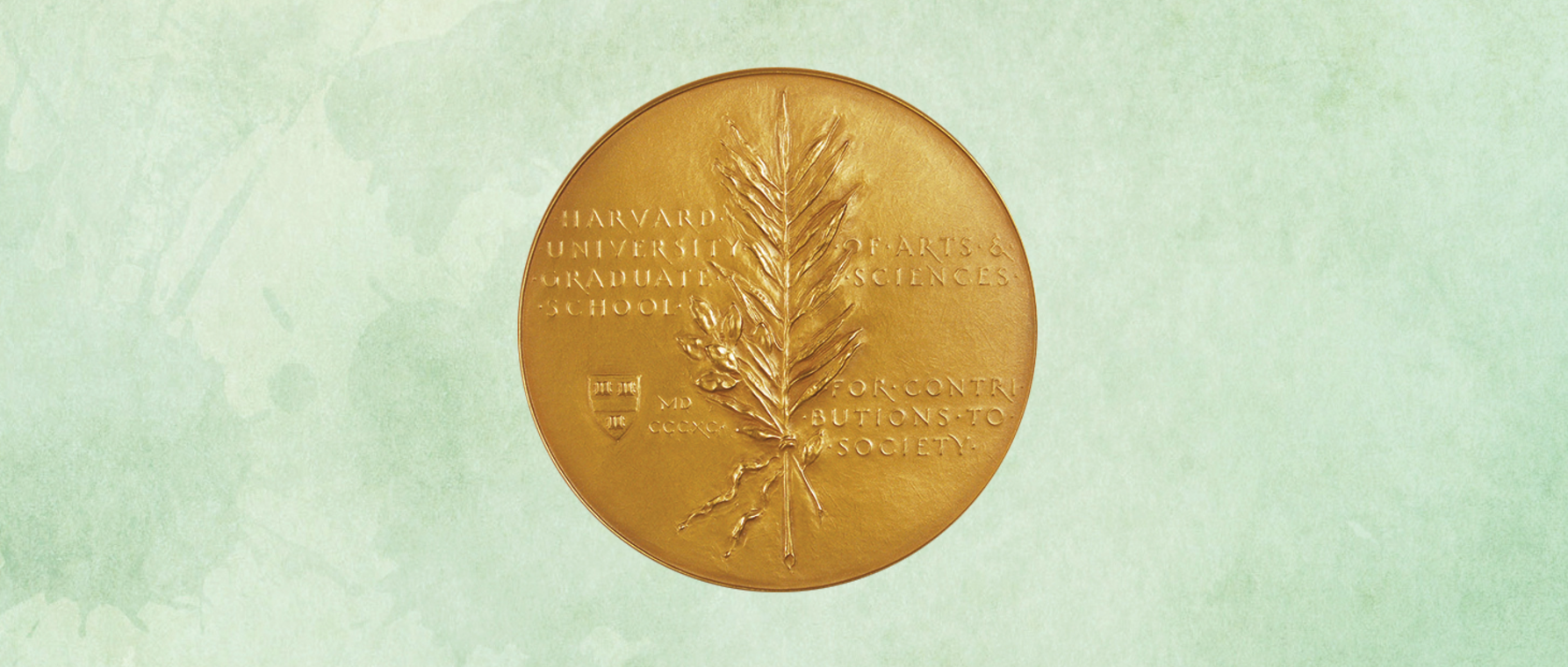
During the 2022–2023 academic year, the Harvard Kenneth C. Griffin Graduate School of Arts and Sciences marked the 150th anniversary of its founding. Throughout this time, the School celebrated the inquiry, innovation, and impact of its alumni and students across the disciplines and throughout the world. It was fitting, then, that Harvard Griffin GSAS brought this special year to a close last May by recognizing with its highest honor—the Centennial Medal—those who exemplify the contributions of the School’s graduates.
“This has been an extraordinary year,” says Dean Emma Dench. “The conversations we convened around the world and the stories we told on our many platforms have left me amazed by Harvard Griffin GSAS alumni, their accomplishments, and their dedication to creating new knowledge. I can think of no better representatives of the School’s remarkable alumni community—and their impact in the world—than our anniversary-year Centennial Medalists. Congratulations to them all!”
Although in recent years the Centennial Medal has been presented to four alumni, this year’s committee decided to honor six—both to mark the School’s anniversary and to replicate the number of medalists in 1989, the first year the award was given, says David Staines, PhD ’73, chair of the Graduate School Alumni Association Council’s Medals Committee. “That and we were so overwhelmed by the quality of graduates we had to choose from,” he says.
Given to graduates who have made outstanding contributions to society, rooted in their education at Harvard Griffin GSAS, the Centennial Medals are “the ultimate accolade,” according to Staines. “These nominees epitomize the top-flight of those who have gone on to have distinguished and elevated careers in their chosen fields.”
This year’s winners also embody the many fields of knowledge studied by the School’s students and graduates, from cell biology and physics to literature, music, and more.
Mina Bissell, PhD ’69

"Choose what you love to do and persist," Mina Bissell wrote in a 2016 essay for the American Society for Cell Biology. And persist she did as a female PhD candidate in bacteriology in the 1960s—despite, as she wrote in a 2017 essay for Molecular Biology of the Cell, “some amazingly bad behavior from a number of men in charge,” despite “a lot of skepticism” about her ideas, despite being told she would never finish her thesis because she was pregnant with her first child. She changed minds, she says, “by just doing it. I was born like that, you know? It was me plus my environment.”
Bissell, who grew up in Iran, credits her parents and extended family—which included lawyers, judges, doctors, and PhDs, many of whom were women—for their positive influence. “They encouraged me to pursue higher education and be independent,” she says.
So perhaps it’s not surprising that after getting her bachelor’s degree in chemistry at Radcliffe and her advanced degree at Harvard Medical School, she made a connection that had been overlooked up to that point. “Everyone was studying DNA because it was new and exciting,” she says of her years at the Lawrence Berkeley National Laboratory, where she started as a postdoc and eventually rose to head of life sciences. “But I asked, if every cell in your body has the same DNA, how does your nose become your nose and not your elbow? And if you have trillions of cells in your body, how can a single cell be sufficient to cause cancer?”
The answer to both questions: environment. Bissell was the first scientist to propose “dynamic reciprocity” between cells and the extracellular matrix (ECM), a network of proteins and other molecules that surrounds them. She proved over and over that the ECM affects changes in gene expression and cell behavior, despite being “teased and laughed at” by colleagues.
No one’s laughing now. Bissell has changed science forever, leading to advances in immunotherapies, wider adoption of the 3D modeling necessary for organoid development, and acceptance of the idea that phenotype can dominate over genotype. According to David Lyden, a professor of pediatrics at Cornell University who first met Bissell at a conference in 2006, her presence and personal magnetism also helped bring her peers around.
[Mina] saw the big picture at a time when it was difficult for women to make a mark in science.
—Dr. Cyrus Ghajar, Fred Hutchinson Cancer Center
“She’s inventive and original and she thinks outside the box,” Lyden says. “When she’s giving a talk, she has star power, almost like an actress on stage. She draws people in so they pay attention to what she’s saying. Without that, her work may have been overlooked.”
Above all, Bissell has succeeded because of her brilliance and the rigor of her work. “She looked at her hypothesis from every angle and it kept turning out to be true,” says Cyrus Ghajar, a biology and public health professor at Fred Hutchinson Cancer Center in Seattle who trained in Bissell’s lab. “She saw the big picture at a time when it was difficult for women to make a mark in science. What she was doing was very much counter to what everyone believed. She saw the holes in the dogma.”
Catherine Cesarsky, PhD ’72

When Catherine Cesarsky was growing up in Argentina, she says she knew nobody who was involved in science. Everyone in her family who had moved from France after World War II when her father took a diplomatic position in Buenos Aires leaned more toward the arts.
“I liked two things: mathematics and nature,” Cesarsky shares. “I liked to look at the stars and the flowers and the sea, and I liked to think that all this was influenced by the principles and laws of chemistry and physics that I learned in school. I found it fantastic that those two things could be brought together.”
In her third year of college at the University of Buenos Aires, where she received her bachelor’s degree in physical sciences, “a professor arrived who was Argentinian but had studied at Harvard,” Cesarsky says. Through a grant from the Carnegie Foundation, Carlos Varsavsky, the first astrophysics teacher the University hired, brought the pieces of a radio telescope to Argentina and asked Catherine Gattegno, her soon-to-be-husband Diego Cesarsky, and a few other students to help him assemble it. He also encouraged Catherine and Diego to apply to his alma mater.
“We both filled out applications for Harvard but didn’t really think it would happen,” Cesarsky recalls. “It seemed a totally unobtainable dream. But on the day of our wedding party, Carlos came and told us we’d both been accepted.” She calls it the best wedding present they could have imagined.
The theoretical work on cosmic rays in Cesarsky’s PhD thesis and in the early years of her career earned her scientific recognition. She eventually led a team of 3,000 scientists as director of the Department of Physical Sciences in France’s Atomic Energy Commission (CEA), served as director general of the European Southern Observatory, and became the first female president of the International Astronomical Union. Her more recent work in infrared astronomy, in particular, made significant contributions to the study of galaxy evolution and helped pave the way for the construction of the James Webb Space Telescope, which launched in 2021.
I liked to look at the stars and the flowers and the sea, and I liked to think that all this was influenced by the principles and laws of chemistry and physics.
—Catherine Cesarsky
Despite these lofty positions, Cesarsky always took time to mentor young scientists, according to Pierre-Olivier Lagage, a senior astrophysicist at CEA, where Cesarsky advised him on his thesis. “Even with her huge responsibilities, she was always very kind,” Lagage says. “She spent time with everybody and was interested in everything, and she could encourage you in such a natural way you didn’t even realize you were being encouraged, but you always went away feeling better. So she made great contributions not only in her own observations, but by passing down her wisdom to the next generation.”
Which is more important than ever, Cesarsky agrees, especially now that technology has brought the world to what she calls a “golden age” of astronomy. “The universe is full of marvelous secrets,” she says. “It’s absolutely amazing how much we’ve learned in just one lifetime. It gives you a different outlook on life.”
John Dower, PhD ’72
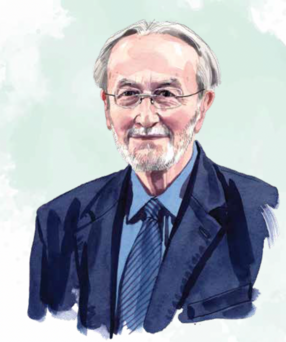
John Dower's first encounter with Japan took place in 1958, when he spent the summer there with a group of American undergraduates. He looks back on this as a “decidedly early postwar experience.” The group’s sponsors believed that bringing together people from different countries, including the recent World War II enemies, could help prevent future conflict. “Japan was still recovering from the trauma and destruction of the war,” Dower recalls. “The so-called economic miracle had not yet taken place.”
“That serendipitous summer is when it all started,” he says of his stay in Kanazawa, a former feudal capital on the west coast of the main island that miraculously escaped US bombing. After graduating from Amherst College in 1959, Dower earned an AM in East Asian studies at Harvard in 1961; worked as a teacher, editor, and book designer in Japan for several years; returned to Harvard in 1965 to pursue a PhD in Japanese literature; and in 1967 switched to history and Far Eastern languages. “The Vietnam War was the trigger for the change,” he says. “I wanted to use Japan and US–Japan relations as a way of comprehending grand issues such as war and peace and race and culture—and to do so at a broadly comparative and interdisciplinary level.”
“John is not shy about taking on challenges,” says "Philip Khoury, PhD ’80, a historian and the associate provost at MIT, where Dower is an emeritus professor of history. “Even when he was an untenured professor he challenged his mentors on their methods, their uses of philology, and their supremist views of other cultures. He’s a hero among many historians for doing that.”
I wanted to use Japan and US–Japan relations as a way of comprehending grand issues such as war and peace and race and culture.
—John Dower
“He shaped how other academics understood Japan,” says Andrew Gordon, PhD ’81, a Japanologist and the Lee and Juliet Folger Fund Professor of History. “But because his writing is so beautiful and so accessible, his books—especially War without Mercy and Embracing Defeat, for which he won the National Book Award and the Pulitzer—reached beyond the academy and had an impact on a wider readership. He humanized Asian cultures by giving people a sense of ordinary life in them.”
In 2000, Dower took on a new challenge when MIT linguistics professor Shigeru Miyagawa asked for his input on a multimedia open online course platform called Visualizing Cultures. “For years, John had been bringing intellectual credibility to images and to pop culture,” Miyagawa says. “I thought this institute-wide platform would be a great place to showcase that kind of history.” The site has since become a prize-winning resource for scholars and a standard reference for visuals in the historical record.
“John’s amazing strength is his persistence when he focuses on a topic,” Miyagawa says. “He keeps digging until he’s satisfied he’s done and he’s written about it in a way that he likes. He really wants to get to the core of the truth of whatever he’s looking at.”
“He’s a major figure in the profession,” Khoury adds, “and just a splendid person. There’s not an honor I can think of he shouldn’t have.”
Du Yun, PhD ’06
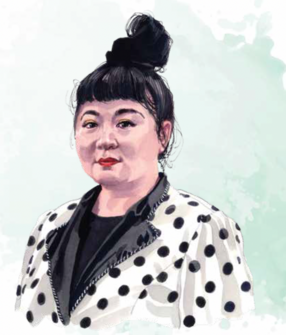
Du Yun "stumbled into music" as a kindergartener in Shanghai when she became fascinated with the pump organ her teacher played. “The other kids would go out for recess, and I would stay inside with this amazing instrument,” she says. Her parents, factory workers whose schooling was interrupted by the Cultural Revolution, bought her a piano and impressed upon her that it was not a toy. “If we get it you have to practice,” they told her.
Yun took that suggestion to the next level, spending eight hours a day training at an age when most kids can’t even tie their shoes. “When I was four, the goal was to get into the Shanghai Conservatory primary school,” she says. “It made getting into Harvard seem easy.” She started out number one in the country’s national ranking and her first four years at the conservatory were “very, very intense.” When Yun slipped to third, she says her teacher became adamant that she not study music. “But I was already dedicated. I had a mind for it and wouldn’t let other people say no to me. So I changed to composition and it felt so liberating. By eight or nine, I realized I wanted to be a bona fide composer who could outgrow the age confinement of the protégé label often given to young musicians.”
After getting her bachelor’s degree in music at Oberlin Conservatory in Ohio, Yun applied to Harvard on the advice of a friend from Oberlin, Erik Spangler, PhD ’04. “I wasn’t even aware Harvard had a composition department,” she says. Yun got a full scholarship as well as a stipend and grants to attend music festivals abroad. “I really have to thank Harvard for that,” she adds. “Not having to worry about basic financial needs gave me the freedom to go places and get my music heard as a young artist.” She wrote Zolle, her first opera, while at the University. “That was the piece that made me confident of who I could be as an artist,” Yun says. “It freed me not just as a composer but also as a performer and storyteller.” Subsequent work has garnered her a Guggenheim fellowship, a Grammy nomination, and a Pulitzer Prize, among many other honors.
By eight or nine, I realized I wanted to be a bona fide composer who could outgrow the age confinement of the protégé label often given to young musicians.
—Du Yun
“In a field in which there’s a lot of categorizations,” says Vimbayi Kaziboni, artistic advisor to the Boston Lyric Opera and an assistant professor at the Boston Conservatory, “where people are put into this box or that box, she has somehow made it her voice to exemplify eclecticism. In one moment, her work will feature an aria, then in the next a punk song, then screaming, then praying—she always finds the best aesthetic for the moment. She’s a very open-minded artist who embraces everything in her work. She has significantly changed the field by making experimentation okay and allowing for anything to happen.”
Daniel Goleman, PhD ’74
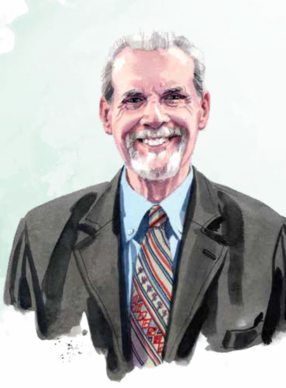
Cary Cherniss, a Psychology Profesor at Rutgers University, remembers being at a conference with Daniel Goleman, author and science journalist, when one of the speakers got bad news about a family member. “The rest of us were standing around and didn’t know what to do,” Cherniss recalls, “and Dan, without even thinking about it, put his arm around the speaker and walked away from the group to talk and listen to her. The empathy he showed struck all of us as really walking the talk on emotional intelligence.”
In 1995, the phrase “emotional intelligence” was known only to a handful of academics, having been introduced in a paper Goleman had come across in his work writing about science for the New York Times. Today, a search on the phrase yields 250 million results.
Goleman’s book on the topic, Emotional Intelligence: Why It Can Matter More than IQ, distilled that paper, by psychologists John Mayer and Peter Salovey, along with a lot of other scientific research about emotion, introducing to a broader audience the idea that interpersonal relationships were at least as important to success in life as book smarts. “It gave a scientific basis to something people recognized intuitively,” Goleman says.
“The book had a huge impact on the field and on society,” Cherniss recalls. “But Dan’s mission from the beginning was to make emotional intelligence more than just a bestselling book that people would talk about for a while and then forget. He wanted a group of reputable, well-known, respected researchers in the area and related areas to really advance emotional intelligence as a science and not just a fad.” He did that, in part, by confounding the Collaborative for Academic, Social, and Emotional Learning, now housed at the University of Illinois at Chicago, to introduce emotional literacy to schools, and, with Cherniss, starting the Consortium for Research on Emotional Intelligence in Organizations at Rutgers. “We still meet twice a year,” says Cherniss, “to connect researchers with senior executives in large corporations and other practitioners.”
Dan’s mission from the beginning was to make Emotional Intelligence more than just a best-selling book that people would talk about for a while and then forget.
—Gary Cherniss, on Dan Goleman's book
Goleman, who received his PhD in psychology from Harvard, saw the importance of the field in part because of a traveling fellowship he did for 15 months in India, where he became interested in meditation, which he wrote about in an earlier book with fellow grad student Richard Davidson. “A foundational skill in emotional intelligence is self-awareness,” Goleman says, “and meditation is a method for that.” At Harvard, he also learned from his mentor, psychology professor David McClelland, about competencies that make a person outstanding in their field. He also connected with another fellow student, Richard Boyatzis, PhD ’73, to expand the concept of emotional intelligence in the business world.
“One of the greatest gifts that a Harvard graduate education gives you is the people you connect with while you’re there,” Goleman says. “I never would have met all these people who influenced me so much if I hadn’t gone to Harvard.”
Sanford Greenberg, PhD ’65
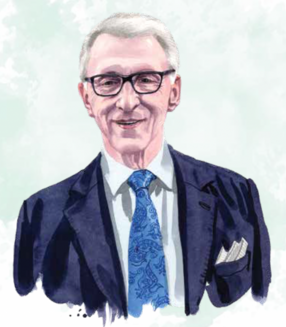
In 1961, Sanford Greenberg was halfway through his junior year at Columbia University when misdiagnosed glaucoma claimed his sight and seemed to foreclose on a promising future. “I went from having 20/20 vision while pitching in a baseball game the previous summer to 0/0 by January,” he says. “I went back home to Buffalo. A social worker came to see me and said, ‘Now that you’re blind, you have the following career choices. You can make screwdrivers. You can cane chairs. Or you can become a justice of the peace.’ That’s when I decided I was going to try to educate myself in government, business, law, and finance, so that if my eyes were gone, at least I’d have my brain to work in different fields.”
Determination, though, is one thing; execution another. Greenberg might never have completed his undergraduate degree if his roommate—singer-songwriter Art Garfunkel— hadn’t shown up on his doorstep that spring to insist Greenberg return to Columbia and promised to be his bridge over troubled water when he did.
“Arthur said, ‘You must come back, Sanford. Darkness,’ as he took to calling himself, ‘is going to read to you,’” Greenberg recalls. “He became one of the many extraordinary human beings who took an hour or two away from studying or dating or resting at Columbia to read to a blind student.”
In that way, Greenberg finished his BA, graduating Phi Beta Kappa and as class president. Greenberg says everybody believed he wouldn’t make it in a major grad school. He remembers them saying, “It’s not in the cards for you.” And yet, Greenberg got into several and chose Harvard because “in those days, as I think is still the case today, it has the best government department in the nation. And I felt if I knew the details of how societies are governed, perhaps I could do something constructive in the commonweal.”
“Constructive” is an understatement. In the next few years, Greenberg would earn his PhD in government from Harvard, attend Harvard Law School, and return to Columbia for an MBA while also attending Oxford University as a Marshall Scholar. Along the way, he invented technology that compressed speech without distorting it, the analog forerunner of today’s MP3 format.
I felt if I knew the details of how societies are governed, perhaps I could do something constructive in the commonweal.
—Sanford Greenberg
In the years since, Greenberg has mixed multiple entrepreneurial endeavors with philanthropic outreach and public service. He started a company eventually worth $80 million, helped renovate Ford’s Theatre in Washington, D.C., worked on US–China relations, served on the National Science Board under Bill Clinton, wrote a book about his life and his relationship with Garfunkel, and much more.
In 2012, Greenberg and his wife, Sue, created the Greenberg Prize, which awards $3 million to scientists who contribute the most to the cause of ending blindness. In 2020, he and Sue distributed the prize among 13 researchers, following that up with the creation of the Sanford and Susan Center to End Blindness, which is affiliated with the world-renowned Wilmer Eye Institute, where Greenberg has served as board chairman for many years.
“For Sandy, light truly emerged from darkness,” says Richard Axel, a Columbia University professor and Nobel laureate.
“If you don’t have the capacity to marvel every morning when you wake up,” Greenberg says simply, “you are losing the magic of this life.”
Get the Latest Updates
Join Our Newsletter
Subscribe to Colloquy Podcast
Simplecast


